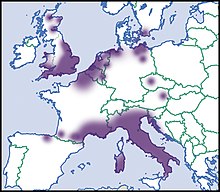Great Carthusian snail
| Great Carthusian snail | ||||||||||||
|---|---|---|---|---|---|---|---|---|---|---|---|---|

Carthusian snail ( Monacha cantiana ) |
||||||||||||
| Systematics | ||||||||||||
|
||||||||||||
| Scientific name | ||||||||||||
| Monacha cantiana | ||||||||||||
| ( Montagu , 1803) |
The great Carthusian snail ( Monacha cantiana ) is a species of snail from the family of leaf snails (Hygromiidae) in the order of land snails (Stylommatophora).
features
The fully grown case is 11 to 14 mm high and 16 to 20 mm wide. It is spherical with a low-conical top. There are 5.5 to 6 vaulted passages, which are set off from one another with a clear, deepened seam. The turns are well rounded on the periphery. The umbilicus is very small and only about one seventh to one ninth of the diameter of the case. It is almost covered by the flap of the mouth in the spindle area. The end turn drops only a little towards the edge of the turn and a little just before the edge of the mouth. The mouth is slightly flattened elliptical. The mouth edge tapers off sharply and is only slightly curved outwards. A faint whitish to reddish lip is formed inside.
The casing is creamy-white, yellowish to brownish and often becomes darker reddish-brown towards the mouth. It's transparent and the dark coat shines through. The surface shows dense growth strips. As a result, the surface only has a weak shine. Near the muzzle can sometimes be a blur. wide, reddish band. Young animals are hairy; hair loses itself with age.
The soft body of the animal is light gray, also slightly reddish in the front part. The tentacles are gray-brown.
Similar species
The shell of the Carthusian snail ( Monacha cartusiana ) is smaller on average. The color contrast of the lip and the edge of the mouth is much clearer, and the navel is also somewhat narrower. The large leaf snail ( Euomphalia strigella ) and the bifurcated shrub snail ( Fruticicola fruticum ) have an additional navel.
Geographical distribution and habitat
The distribution area was probably originally limited to Italy, southern France and northern Spain. It was probably already deported to north-west France, the Benelux countries and southern England, possibly even to northern Germany, in Roman times. It is extremely rare in Germany. It was first detected in the Czech Republic in 2010.
The habitat of the Great Carthusian Snail is the herbaceous layer of roadsides, railway lines, hedges, wasteland and scrub: they can also be found on dikes and in dunes. It prefers to live on well-drained, chalky soils. It does not occur in the forest.
Way of life and reproduction
The animals move slowly forward and shed a colorless slime at the slightest disturbance. The young live longer in the higher areas of the herb layer.
In England, copulation was observed between May and September. The semen is transferred through a spermatophore. The spherical to slightly egg-shaped eggs have a lime shell and the egg diameter is 1.5 to 2.2 mm. According to observations on animals in northern France, between June and September around 60 to 90 eggs are laid in loose, moist soil. The young hatch after 14 to 15 days, in England also up to 20 days between June and September. They become sexually mature within a year, often before the shell has reached its final size. They live to be 12 to 18 months old.
Taxonomy
The taxon was first described to Georg Montagu in 1803 as Helix cantiana . The species is now generally recognized as belonging to the genus Monacha Fitzinger, 1833.
Danger
It is extremely rare in Germany and the degree of risk is therefore difficult to determine. The risk is not yet known for the entire distribution area ( low concern ).
literature
- Rosina Fechter, Gerhard Falkner: Mollusks. 287 p., Mosaik-Verlag, Munich 1990 (Steinbach's Nature Guide 10) ISBN 3-570-03414-3 (p. 220)
- Michael P. Kerney, Robert AD Cameron & Jürgen H. Jungbluth: The land snails of Northern and Central Europe. 384 pp., Paul Parey, Hamburg & Berlin 1983 ISBN 3-490-17918-8 (p. 253)
- Francisco W. Welter-Schultes: European non-marine molluscs, a guide for species identification = identification book for European land and freshwater mollusks. A1-A3 S., 679 S., Q1-Q78 S., Göttingen, Planet Poster Ed., 2012 ISBN 3-933922-75-5 , ISBN 978-3-933922-75-5 (hereinafter abbreviated as Welter-Schultes , Identification book with corresponding page number)
- Vollrath Wiese: Germany's land snails. 352 S., Quelle & Meyer, Wiebelsheim 2014 ISBN 978-3-494-01551-4 (in the following abbreviated meadow, land snails with corresponding page number)
Individual evidence
- ↑ Welter-Schultes, Identification Book, p. 504.
- ↑ Jaroslav Č. Hlaváč, Alena Peltanová: First occurrence of the Kentish Snail Monacha cantiana (Mollusca: Gastropoda: Hygromiidae) in the Czech Republic. Malacologica Bohemoslovaca, 9: 11-15, 2010 ISSN 1336-6939
- ↑ June E. Chatfield: The life history of the helicis snail Monacha cantiana (Montagu), with references also to M. cartusiana (Müller). Proceedings of the malacological Society of London, 38: 233-243, 1968
- ↑ George Montagu: Testacea Britannica, or natural history of British shells, marine, land, and fresh-water, including the most minute: systematically arranged and embellished with figures. Pp. I-XXXVII (= 1-37), pp. 1-606, White, London 1803 Online at Biodiversity Heritage Library , p. 422.
- ↑ MolluscaBase: Monacha cantiana Version from December 20, 2017
- ^ Wiese, Landschnecken, pp. 294/95.
- ↑ IUCN Red List: Monacha cantiana
